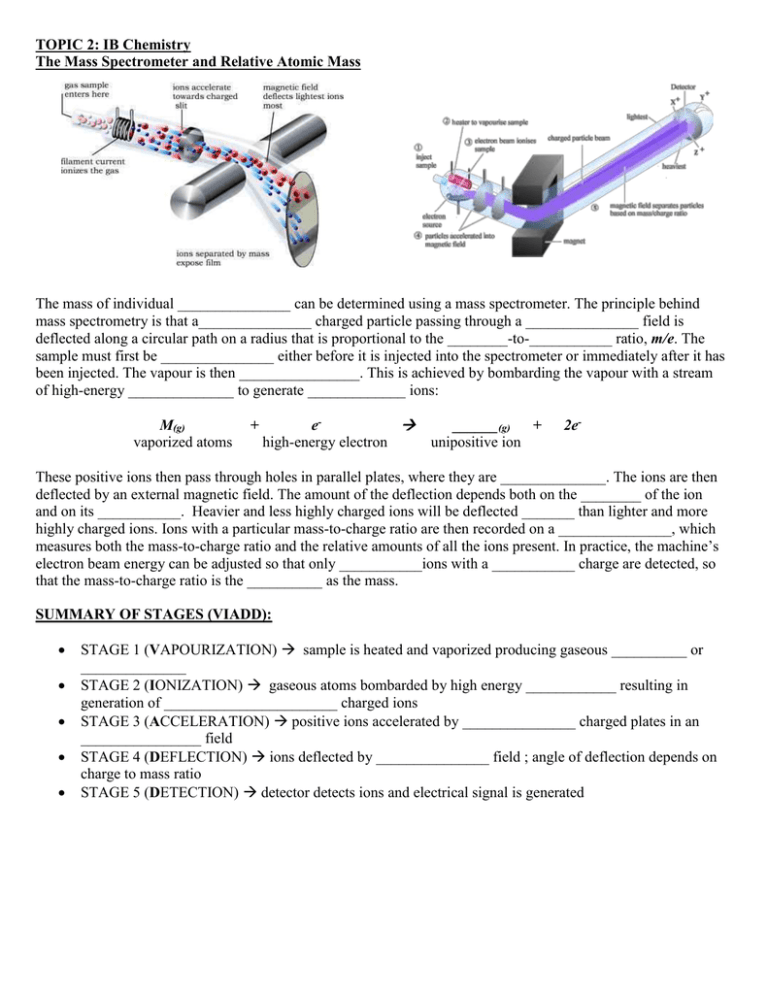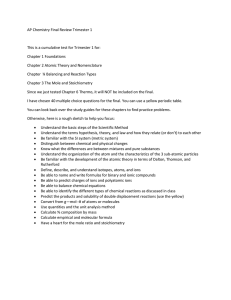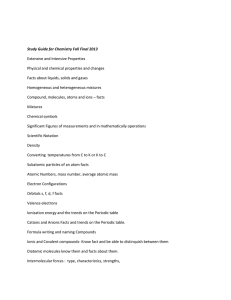TOPIC 2: IB Chemistry The Mass Spectrometer and Relative Atomic Mass
advertisement

TOPIC 2: IB Chemistry The Mass Spectrometer and Relative Atomic Mass The mass of individual _______________ can be determined using a mass spectrometer. The principle behind mass spectrometry is that a_______________ charged particle passing through a _______________ field is deflected along a circular path on a radius that is proportional to the ________-to-___________ ratio, m/e. The sample must first be _______________ either before it is injected into the spectrometer or immediately after it has been injected. The vapour is then ________________. This is achieved by bombarding the vapour with a stream of high-energy ______________ to generate _____________ ions: M(g) vaporized atoms + e high-energy electron ______(g) + unipositive ion 2e- These positive ions then pass through holes in parallel plates, where they are ______________. The ions are then deflected by an external magnetic field. The amount of the deflection depends both on the ________ of the ion and on its ___________. Heavier and less highly charged ions will be deflected _______ than lighter and more highly charged ions. Ions with a particular mass-to-charge ratio are then recorded on a _______________, which measures both the mass-to-charge ratio and the relative amounts of all the ions present. In practice, the machine’s electron beam energy can be adjusted so that only ___________ions with a ___________ charge are detected, so that the mass-to-charge ratio is the __________ as the mass. SUMMARY OF STAGES (VIADD): STAGE 1 (VAPOURIZATION) sample is heated and vaporized producing gaseous __________ or ______________ STAGE 2 (IONIZATION) gaseous atoms bombarded by high energy ____________ resulting in generation of _______________________ charged ions STAGE 3 (ACCELERATION) positive ions accelerated by _______________ charged plates in an ________________ field STAGE 4 (DEFLECTION) ions deflected by _______________ field ; angle of deflection depends on charge to mass ratio STAGE 5 (DETECTION) detector detects ions and electrical signal is generated Relative Atomic Mass Problems: RECALL: The relative atomic mass, Ar, is the ratio of the average mass of the atom to 1/12 the mass of a C-12 atom. (Alternately stated: ….the ratio of the average mass of the atom to the unified atomic mass unit.) *Relative atomic mass is a ratio so it does not have units!) The unified atomic mass unit is a non SI unit of mass and is defined as one-twelfth the mass of a C-12 atom in its ground state. This unit is used to express masses of atomic particles (1 amu = 1 u = 1.6605402 x 10-27 kg = the mass of an H-1 atom) 1. Calculations: a) Following mass spectrometry analysis, it is found that lead occurs naturally as four isotopes. These isotopes 206 207 208 are 204 82 Pb (1.37%, 204.0), 82 Pb (26.26%, 206.0 ), 82 Pb (20.82%, 207.0), and 82 Pb (51.55%, 208.0). Calculate the relative atomic mass of lead. b) An approximation is often made that naturally occurring chlorine contains 75% chlorine-35 and 25% chlorine-37. This would give a relative atomic mass of 35.5. However, according to the IB Data Booklet the relative atomic mass of chlorine is 35.45. Calculate to two decimal places the actual percentage of chlorine-35 in naturally occurring chlorine. c) Examine the mass spectrum on p. 49 of the text. Deduce the relative atomic mass of the element X from its mass spectrum and identify X from the periodic table.





